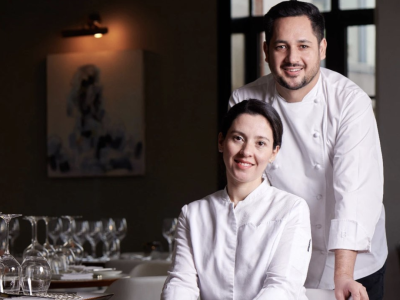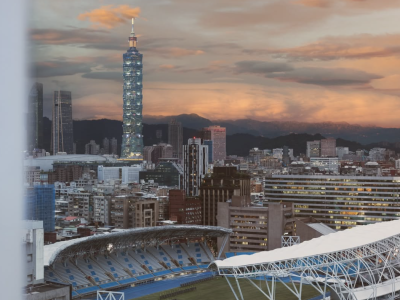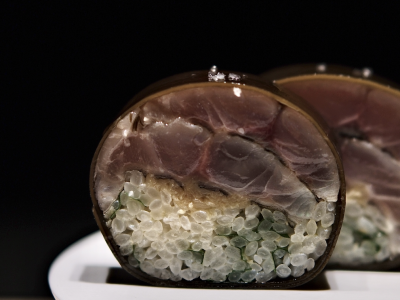In a recent conversation with a chef, I casually asked, “How have things been lately?” He responded with a faint, weary smile, then quietly began talking about the pressure he had been under. He admitted that some media outlets had requested the restaurant cover their flights and accommodation for a “visit experience.” For a small restaurant, this is a heavy burden to shoulder. That moment sparked a line of reflection for me: in the glow of prestigious global rankings, what kind of invisible pressure are independent restaurants—those without corporate backing—facing just to be seen?
When the 2025 edition of The World’s 50 Best Restaurants was revealed on June 19 in Turin, Italy, most of the industry’s attention turned, as expected, to the newly crowned number one and the shifts in this year’s rankings. But behind the applause and celebration, I kept thinking of that conversation. What kind of resource investment goes into shaping these rankings? This year, Maido (No. 1) in Lima, Peru took the top spot, followed by Asador Etxebarri (No. 2) in Atxondo, Spain, and Quintonil (No. 3) in Mexico City. Interestingly, Quintonil is categorized as part of North America on the global list, yet it also appears on the Latin America list—an overlap that has puzzled some.
This year marks the first time that Central and South America have had an overwhelming presence in the top ten. According to analysis by XtremeFoodies, Latin America is divided into four voting regions with around 160 voters total, while the entire Iberian Peninsula—Spain and Portugal combined—shares just one voting region, with roughly 40 voters. That means Latin America enjoys a built-in numerical advantage when it comes to votes. Some observers also noted that following the 2024 Latin America’s 50 Best awards, Maido hosted a lavish 15th anniversary party attended by more than a thousand guests. That celebration is now widely seen as a key moment in securing this year’s top spot—perhaps also explaining why so many cities are eager to host the awards in future years.
Some observers also noted that following the 2024 Latin America’s 50 Best awards, Maido hosted a lavish 15th anniversary party attended by more than a thousand guests. That celebration is now widely seen as a key moment in securing this year’s top spot—perhaps also explaining why so many cities are eager to host the awards in future years.
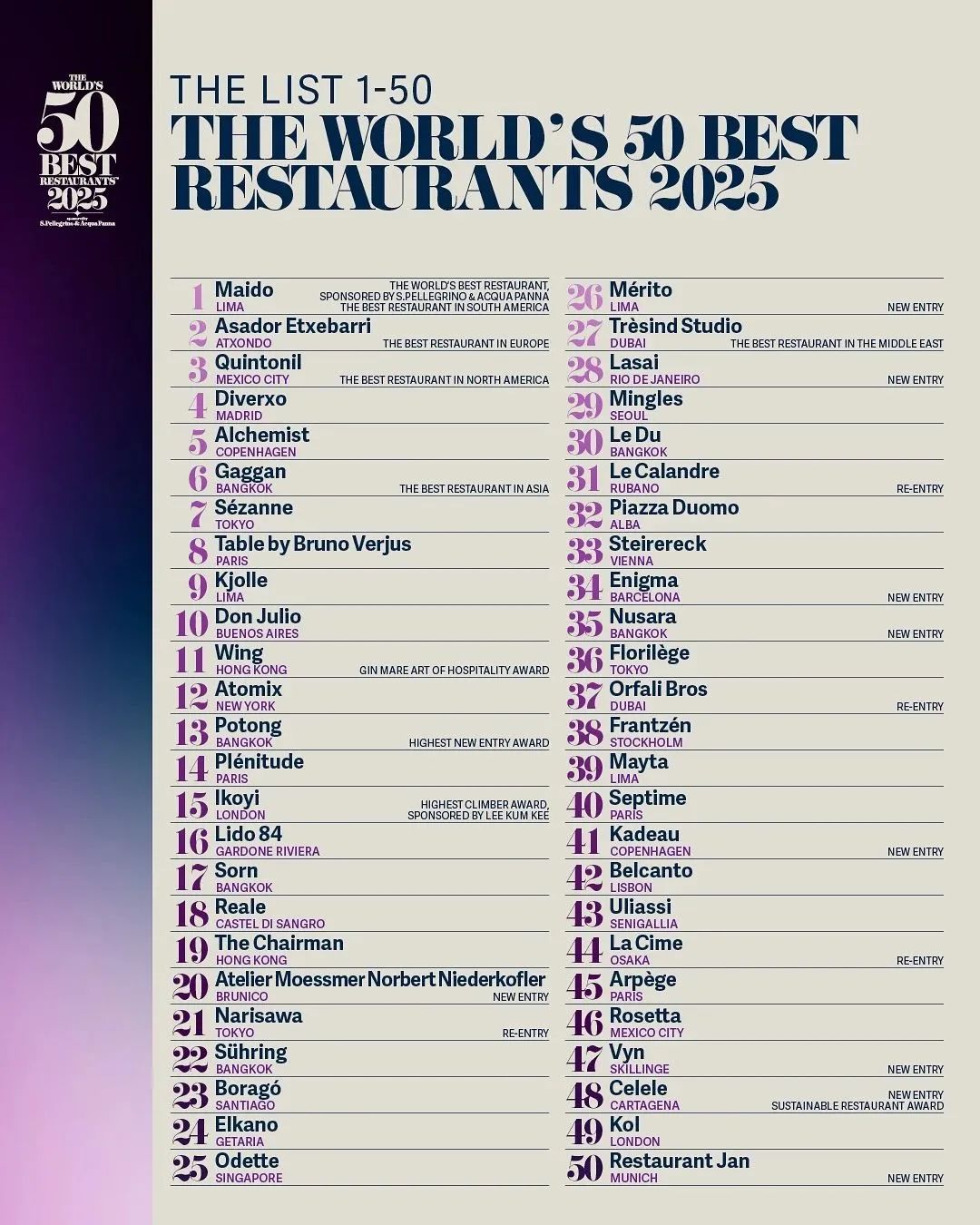 World's 50 Best 2025
World's 50 Best 2025
Europe: Italy Leads, Nordic Forces Rising
Europe still dominates the list overall, with 23 restaurants included — two more than last year. Italy performed particularly well with six restaurants ranked. Atelier Moessmer (No. 20), a three-star restaurant located in Brunico in northern Italy, reentered the list with a refreshed identity. Aside from Lido 84 (No. 12), the others are all established three-Michelin-star institutions. Spain’s total number dipped slightly due to Disfrutar’s (last year’s No. 1) graduation into the “Best of the Best” hall of fame. Meanwhile, several of the iconic three-star restaurants in the Basque Country have gradually faded from the list over time.
Asador Etxebarri: A Counterexample to the System
Asador Etxebarri (No. 2), located in the Basque Country, stands as a striking counterexample to the system. Over the past decade, “live-fire cooking” has emerged as a global trend, replacing the dominance of molecular gastronomy and New Nordic cuisine. At the heart of this shift is chef Víctor Arguinzoniz, whose restaurant has maintained a top-ten position for ten years—without PR support, without media tours, and without the chef ever leaving his restaurant. Many had hoped this would be the year he’d finally reach the top, on his own terms. The idea of him taking the stage, receiving a ten-minute standing ovation, had already formed in our minds. But once again, the top spot slipped through his fingers.
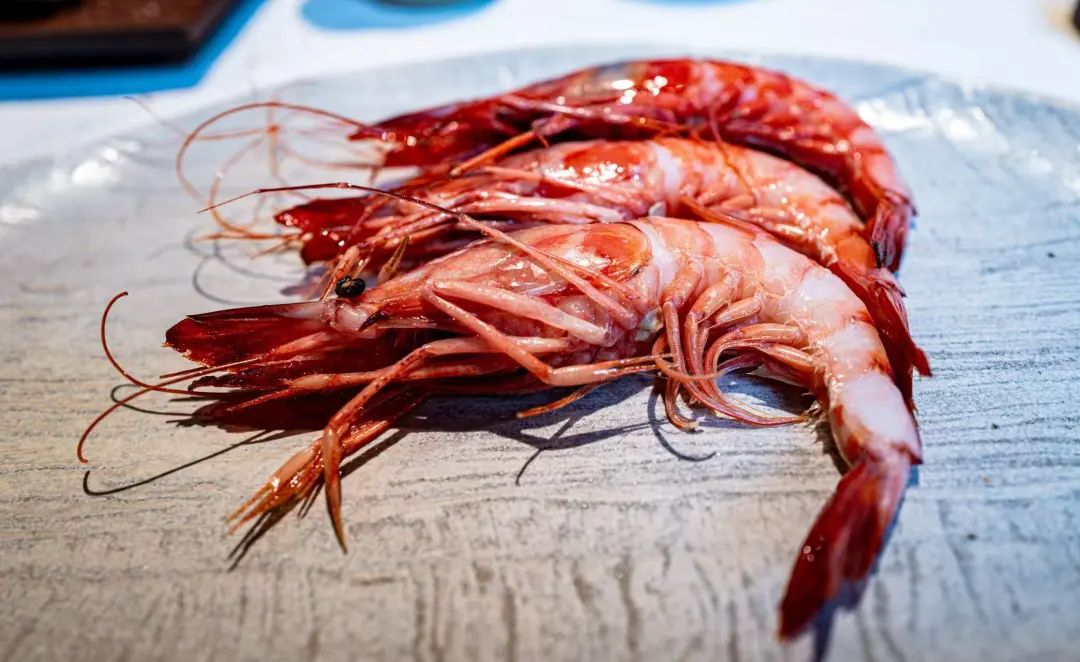 Asador Etxebarri, Photo by Edward Hu
Asador Etxebarri, Photo by Edward Hu
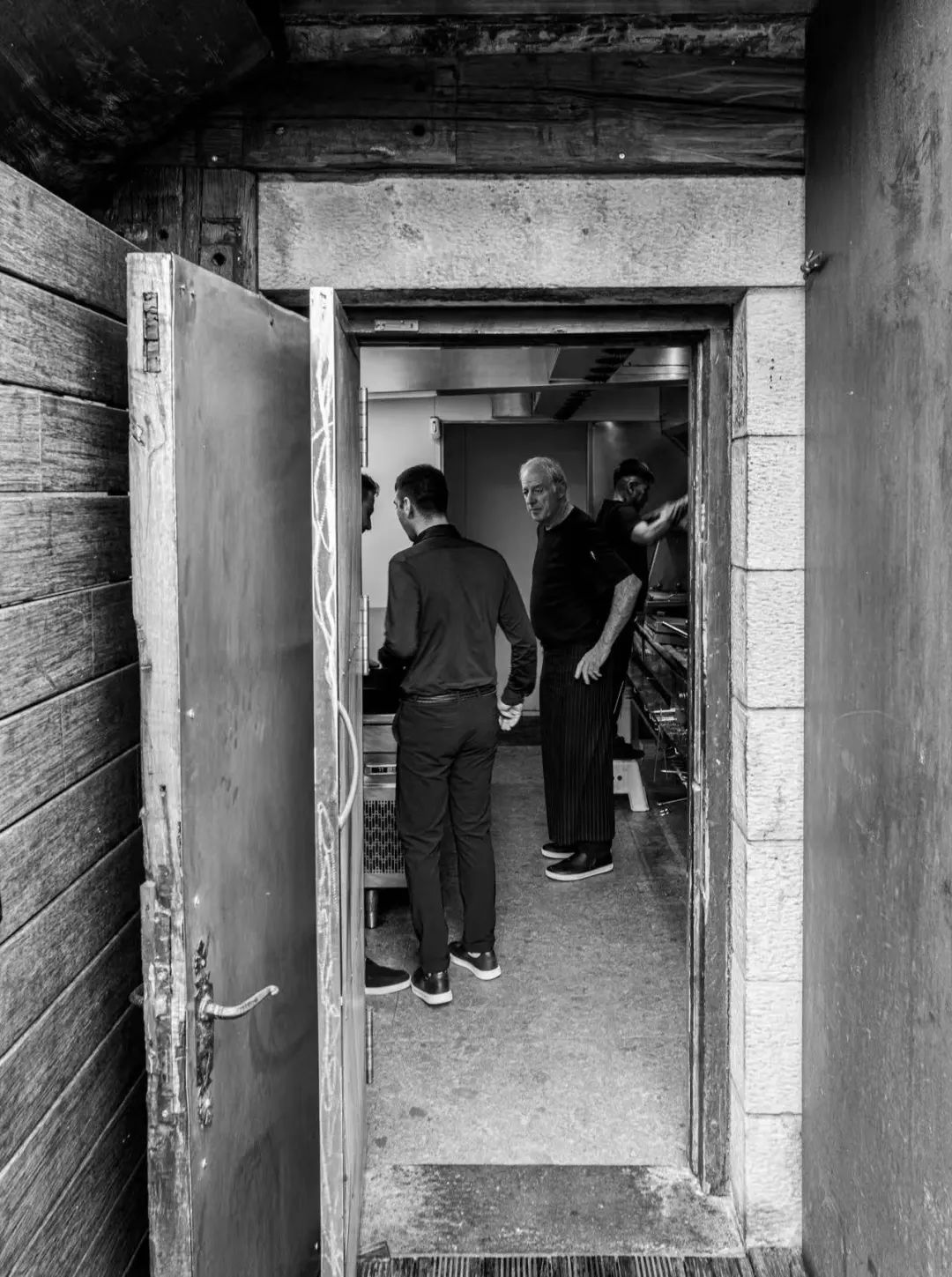 Asador Etxebarri, Photo by Edward Hu
Asador Etxebarri, Photo by Edward Hu
 The author (left) with Mohamed Benabdallah (right), World's Best Sommelier 2025, Photo by Edward Hu
The author (left) with Mohamed Benabdallah (right), World's Best Sommelier 2025, Photo by Edward Hu
The Eternal White Rose of the North
In Northern Europe, many are watching to see when Alchemist (No. 5) in Copenhagen will claim the crown. Alchemist has been ranked in the top 11 for a while, and now that both Noma and Geranium have earned the No. 1 title and moved into the hall of fame, Alchemist is finally a contender. Two new Nordic entries also made it into this year’s list on merit: Vyn (No. 47) in Sweden and Kadeau (No. 41) in Denmark, both two-Michelin-star restaurants, underscoring the region’s continued relevance in global fine dining.
Copenhagen's Alchemist@Jocelyn華姐的TastyTrip YouTube
Asia: Thailand Ascends, Japan Holds Steady, Hong Kong Stands Out
In Asia, the number of ranked restaurants grew from 12 last year to 14. Thailand led the region, with six Bangkok-based restaurants featured, including two newcomers: Potong (No. 13) and Nusara (No. 35). Gaggan (No. 6), also in Bangkok, now holds the highest ranking of any Asian restaurant. Its strategy—aggressive PR and extensive hosting—has long been an open secret in the industry. Hong Kong’s Wing (No. 11) made a particularly strong leap from last year’s No. 20, making it one of the most improved Asian restaurants on the list.
Japan remained consistent in its performance. La Cime (No. 27) in Osaka and Narisawa (No. 48) in Tokyo both returned to the list, joining Florilège (No. 20) and Sézanne (No. 15), both in Tokyo. It’s worth noting that Japanese restaurants generally avoid heavy marketing investment or active invitation strategies, and thus their positions on the list have stayed relatively stable. Many consider Japan to be home to more outstanding restaurants than anywhere else in the world, yet the current voting system often seems to undervalue them. Interestingly, OAD has created a separate Japan region in its rankings, a pragmatic decision that gives low-profile Japanese restaurants a fairer shot.
Florilège, Tokyo@Jocelyn华姐的TastyTrip YouTube
Middle East and the Rest of the World
The Middle East, boosted by the arrival of both the Michelin Guide and the World’s 50 Best, has begun to gain more global attention. Dubai now has two restaurants on the list: the newly three-starred Indian fine dining spot Trèsind Studio (No. 27) and newcomer Orfali Bros (No. 37). In contrast, North America now has just one restaurant left in the top 50—Atomix (No. 6) in New York—while all other U.S. entries have fallen off the list entirely. The upcoming launch of the “North America’s 50 Best” raises questions: will it attract global attention or repeat the Latin American pattern, reinforcing regional dominance in the global list?
Systemic Structures and Blind Spots
While it’s true that most of the restaurants on the list are of high caliber, we can’t overlook the fact that some achieve their position through significant PR investment—covering flights, lodging, and elaborate hosting. In the industry, this has become an open secret. Over time, the ranking’s numbers and placements begin to lose meaning. It’s no longer like watching a sporting event where performance determines the outcome. Here, the metrics feel increasingly opaque.
Although voting results are audited by a third party, the real issue lies elsewhere: who gets to vote, how are they chosen, and whether they’re qualified to do so with fairness and expertise. There’s no real oversight of these processes. In this digital age, does true anonymity still exist? Can anonymous voters be impersonated? Some have even pointed out that a few voters rarely pay for meals themselves—are such individuals truly fit to judge?
Chefs, PR Campaigns, and the Competitive Undercurrent
Chefs, too, are part of the equation. In pursuit of higher rankings, many spend much of the year networking across borders, appearing at media events and collaborative dinners. Some are rarely found in their own kitchens. Meanwhile, younger chefs with fewer resources invest their time in “four-hands” dinners across countries, hoping their peers will introduce them to a broader audience. This, in turn, has shaped the media ecosystem: some invited “media” are barely credible, some streamers posing as chefs, and others chase viral fame with shallow content. In this age, clicks matter more than substance, and flashy imagery often outshines thoughtful critique.
Michelin vs. World’s 50 Best: Two Very Different Systems
It’s worth comparing this system with that of the Michelin Guide. Michelin also uses anonymous inspectors, but the difference is crucial: they’re salaried full-timers, and the guide pays for their meals. That means no financial burden falls on the restaurant, and less opportunity for marketing tactics to influence results. Michelin stars still provide a form of professional validation. That said, Michelin is also becoming more media-driven, and it’s unclear whether it will remain immune to the same pressures.
None of this is to deny the significance of the World’s 50 Best. Over the past two decades, it’s made enormous contributions to the culinary world. It’s brought chefs and restaurants to global prominence, created immense commercial value, and turned chefs into international stars. But the system now faces new challenges and underlying concerns that are worth openly acknowledging.
Rankings in Bloom: W50, OAD, Best Chef Awards
At the same time, other rankings are rising. OAD (Opinionated About Dining), which is based on votes from serious diners, and The Best Chef Awards, once dismissed as unserious, now boast over a million Instagram followers and growing credibility (W50 has around 1.8M followers ).
These rankings are not necessarily more comprehensive, but they offer alternative perspectives.
For example, OAD once named Ultraviolet (Shanghai) its best restaurant in Asia—a recognition from diners who paid for the experience. In 2024, Rasmus Munk of Alchemist (W50 No. 5) was named Best Chef of the Year by The Best Chef Awards, even though his restaurant didn’t top the W50 list. “Best” clearly has more than one definition.
 Rasmus Munk of Alchemist, 2024 Best Chef of the Year by The Best Chef Awards
Rasmus Munk of Alchemist, 2024 Best Chef of the Year by The Best Chef Awards
Each ranking has its strengths. The World’s 50 Best brings Oscar-like glamour. OAD highlights the tastes of seasoned gastronomes and is a great tool for discovering emerging talent. The Best Chef Awards places the spotlight on individual creativity. Each list also has its flaws. The World’s 50 Best is often criticized for being PR-driven. OAD is viewed as an elite club, out of touch with everyday diners. The Best Chef relies heavily on fan voting. In the end, each serves a different purpose and a different audience.
Reflection: Between Visibility and Sustainability
Rankings offer visibility, but they also bring pressure. If a restaurant comes to rely too heavily on list placement as a business strategy, what happens when that ranking slips or the media spotlight shifts? Does that signal failure? For any restaurant owner, this is a dangerous temptation. Most industry insiders know which restaurants are “PR players” and which are built on real substance—and the cost of heavy PR will eventually be passed on to real paying guests.
So how should a restaurant balance the pressures of media and rankings? I believe the answer lies in choosing long-term values over short-term rewards. What matters more is whether the media outlet provides sustained benefit, and whether the restaurant’s operation remains sustainable. I also think of the many restaurants that persist quietly behind the scenes, without lavish budgets, simply focused on making good food. For chefs looking to expand their network, nearly all award organizers are happy to offer entry passes—there’s no need to overspend on hospitality campaigns.
Working within your means, operating sustainably, and creating an experience that customers return to—those are the things that truly matter.
Haruki Murakami once said: "Between a high, solid wall and the egg that breaks against it, I will always stand on the side of the egg. No matter how right the wall may be, and how wrong the egg, I will stand with the egg."He was speaking about the struggle between the individual and the system. I think of this often when reflecting on restaurants and the ranking structures around them. Let’s not forget: some restaurants are not just chasing awards—they are standing, quietly, on the side of the egg.
References:
World Journal
– Eater:《The World’s 50 Best Restaurants 2025: The Full List of Winners》
– The National:《Michelin Guide awards three stars to Dubai restaurants Tresind Studio》
– XtremeFoodies Substack by Jeffrey Merrihue:《The Best Restaurant in The World》
– NDTV:《This Indian Restaurant In Dubai Was Just Awarded A 3rd Michelin Star》


